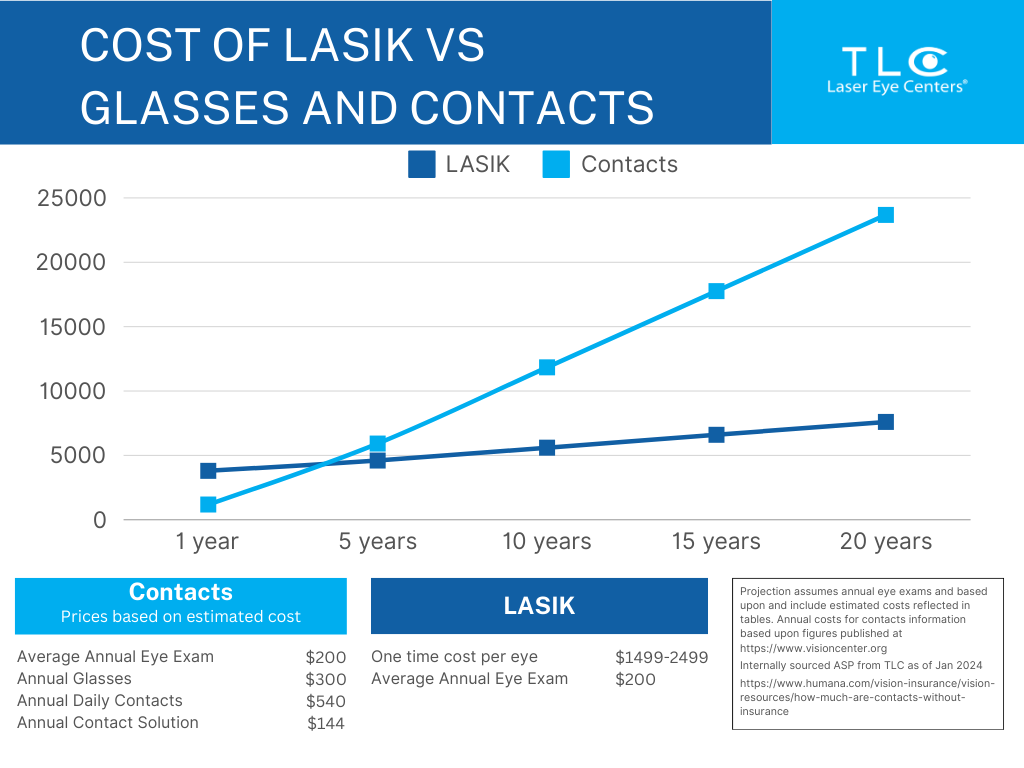How Much Does LASIK Cost in 2025?
Thinking about LASIK surgery is a huge step – it’s about seeing life clearly, without glasses or contacts. And, naturally, one of the first questions on everyone’s mind is always: “How much does LASIK really cost?” Here at TLC Laser Eye Centers, we believe you deserve straight answers and complete clarity. We’re here to help you understand your investment and show you just how achievable clear vision can be.
This guide is all about giving you the real scoop on LASIK costs in 2025. We’ll break down what goes into the price, uncover ways to save, and explain the incredible long-term value of choosing LASIK.
Breaking Down Your LASIK Investment: What You’ll Actually Pay in 2025
Nationwide, the cost of LASIK eye surgery can vary quite a bit, typically falling somewhere between $1,500 to $5,000 per eye. This range depends on things like the technology used, your surgeon’s experience, and where you live.
At TLC, we’re all about upfront, all-inclusive pricing. Our standard fee for advanced procedures is usually between $2,495 – $2,895 per eye. That includes cutting-edge technologies like bladeless LASIK with Wavefront optimization. Many of our patients actually end up paying closer to around $2,000 per eye once their insurance benefits and any employer discounts are applied.
A Quick Word About “Bargain” LASIK: It’s tempting to go for the lowest price tag, but it’s super important to know exactly what’s included. Those “too good to be true” deals often leave out crucial parts of the process, like:
- Thorough eye evaluations before your surgery
- The most advanced laser technologies (like custom, personalized Wavefront)
- All your necessary follow-up appointments
- Important long-term guarantees (like lifetime enhancements)
At TLC, we promise no hidden fees. We’re committed to the highest quality of care and back our work with our unique TLC Lifetime Commitment® program.
Why Choose TLC? Our Experience & Trust Speak for Themselves
When it comes to something as precious as your eyesight, trust is everything. TLC Laser Eye Centers isn’t just another provider; we’re North America’s largest LASIK specialist, with a track record stretching back over 30 years. Our vast experience means real peace of mind for you.
Here’s why so many people trust TLC with their vision:
- Over 5.5 Million Procedures: We’ve done more laser vision correction procedures than anyone else in North America. That kind of experience gives us a deep understanding of every unique eye.
- 7,000+ Doctors Chose Us: It’s the ultimate vote of confidence – over 7,000 medical professionals have picked TLC for their own LASIK surgery.
- Team-Based Care: We work hand-in-hand with your regular eye doctor, both before and after your procedure. This collaborative approach helps ensure a smoother, safer experience and better results.
- Leaders in Technology: We’re always investing in and refining the very latest LASIK technologies, so you get the most advanced and safest options available.
Choosing TLC means you’re investing in unmatched experience, the best technology, and a dedicated team focused entirely on helping you achieve your best possible vision.
What Goes Into Your LASIK Cost? The Main Factors
Understanding what makes up the cost of LASIK helps you see the bigger picture and make a smart choice for your eyes.
1. Your Surgeon’s Experience & Reputation
Highly experienced LASIK surgeons, those who’ve performed thousands of successful procedures, naturally reflect their expertise in their pricing. This covers years of specialized training, ongoing learning, and a proven history of amazing patient results. Picking an expert surgeon is truly an investment in your safety and the quality of your vision.
2. Advanced Technology & Customization
The type of technology used is a big part of the LASIK cost. Modern LASIK has come a long way, offering incredible precision and personalization that older methods just can’t match.
| Technology Feature | What it is | Why it matters (cost & Your Benefit) |
|---|---|---|
| Bladeless (Femtosecond) LASIK | Uses a laser (no blade!) to create the corneal flap. | Safer & More Precise: Reduces risks, allows for a more customized flap. This advanced method is standard at top centers like TLC. |
| Wavefront-Guided LASIK | Creates a super detailed, 3D map of your eye’s unique imperfections. | Sharper Vision: Corrects issues like glare and halos (called “higher-order aberrations”) for clearer vision, especially at night. It’s how we personalize your treatment for amazing results. |
Choosing sophisticated, modern technology is key for getting the best results and ensuring your safety.
3. Your Full Care Package: Before, During & After Surgery
A truly valuable LASIK investment includes comprehensive care from start to finish. This full package means:
- Detailed Consultation & Evaluation: A super thorough check of your eye health, making sure LASIK is right for you, and designing your personalized treatment plan.
- The Surgery Itself: The actual laser correction procedure.
- All Your Follow-Up Appointments: So important for watching your healing and answering any questions you have afterward.
- Post-Op Medications: Any prescriptions you’ll need for comfort and healing.
- Long-Term Enhancement Guarantee: Programs like our TLC Lifetime Commitment® give you peace of mind, covering enhancement procedures if your eyes ever change down the road.
If a provider charges a much lower initial price, they might be leaving out these vital parts, leading to surprise costs later and potentially less comprehensive care.
Making LASIK Affordable: Smart Ways to Pay
Worried about the upfront cost of LASIK? Don’t be! There are lots of flexible options available to make this life-changing procedure much more manageable.
1. Smartly Use Your Health Spending Accounts
Many people can use tax-advantaged accounts to significantly lower their out-of-pocket costs for LASIK. Good news: LASIK counts as an eligible expense for all these accounts:
- Flexible Spending Accounts (FSA): You put pre-tax money in, then use it for qualified medical expenses within that year.
- Health Savings Accounts (HSA): These contributions are tax-deductible, grow tax-free, and you can use them anytime for qualified medical expenses.
- Health Reimbursement Arrangements (HRA): These are employer-funded accounts for medical expenses.
Pro Tip: During your employer’s open-enrollment, think about boosting your contributions to these accounts. It’s a smart way to save up for LASIK next year, potentially saving you hundreds, even thousands, in taxes!
2. Check for Insurance Savings & Employer Programs
While regular health insurance usually sees LASIK as an elective procedure, you might still find some great LASIK insurance savings:
- Employer & Union Discounts: TLC Laser Eye Centers actually has special agreements with many employers and union groups, offering exclusive discounts. It’s worth asking!
- Vision Plans: Some vision insurance plans or discount programs might offer reduced pricing on LASIK. Always check your specific benefits.
3. Flexible Financing Options
Don’t let the initial cost stop you from getting clear vision. Many patients choose to finance their LASIK, spreading the investment out into easy monthly payments.
- TLC Financing Options: We work with trusted financing partners to offer plans with low or even no interest. Often, these monthly payments can be similar to a small utility bill.
- Credit Cards: Using a rewards credit card can be an option if you want to earn points or miles. Just make sure your chosen LASIK provider accepts it.
We’re here to help you figure out all these options during your complimentary consultation.
The True Value of LASIK: It’s More Than Just a Price Tag
While the cost of LASIK is definitely a big consideration, this procedure is so much more than just an expense. It’s a smart investment in a lifetime of better vision and a significantly improved quality of life.
Saving Money Over Time: Glasses & Contacts vs. LASIK
If you wear prescription contacts or glasses, you likely spend over $854 annually on replacements and supplies. According to average costs of popular brands, this includes $540 per eye per year for daily disposable contacts, up to $144 per year for contact lens solution, and $300 or more for new glasses frames and lenses. That all adds up to around $1,184 total per year.

After just a few years, what you spend on glasses and contacts can often exceed the one-time investment in LASIK. In the long run, LASIK usually means big financial savings.
Lifestyle ROI: The Priceless Freedom of Clearer Vision
Beyond the money you save, LASIK offers an invaluable Return on Investment (ROI) in your daily life. Imagine the pure freedom of:
- No more glasses slipping down your nose during sports or in humid weather.
- No more dry, irritated eyes from contacts.
- Waking up and seeing clearly, immediately – no fumbling for glasses in the dark!
- Saying goodbye to cleaning lenses or running out of supplies.
- Wearing any sunglasses you want, off-the-shelf.
LASIK truly empowers you to dive into the activities you love, totally unhindered:
- SCUBA diving and splashing in the pool
- Playing freely with your kids without worrying about broken glasses
- Stress-free travel
- And simply seeing the world with crisp, clear vision, every single moment.
For many, these profound life improvements are the most compelling reason to choose LASIK, easily outweighing the initial financial outlay.
Choosing Your LASIK Provider: It’s All About Quality, Not Just Price

It’s super important to look at the total value of your LASIK procedure, not just the initial price tag. Going for the cheapest option might mean compromising on safety, accuracy, and ultimately, your long-term vision success.
Surgeon’s Credentials and Experience
Research the credentials and experience of the LASIK surgeon. Look for certifications, affiliations, and a track record of successful surgeries. Patient reviews and testimonials can also provide valuable insights into a surgeon’s reputation.
Technological Advancements and Facilities
Evaluate the technologies and equipment used by the LASIK provider. Advanced laser platforms and diagnostic tools contribute to safer procedures and improved visual outcomes. A well-equipped facility with a focus on patient comfort and safety is also crucial.
Patient Education and Communication
A reputable LASIK provider will prioritize patient education and communication. They will thoroughly explain the procedure, address any concerns or questions, and provide realistic expectations regarding the potential results and recovery process.
Post-Operative Care and Guarantees
Inquire about the post-operative care provided by the LASIK provider. A comprehensive follow-up plan, including regular appointments and access to medical support, demonstrates a commitment to patient well-being. Guarantees or lifetime commitment programs further indicate the provider’s confidence in their surgical outcomes.
At TLC Laser Eye Centers, our promise is exceptional LASIK experiences without cutting corners on quality or transparency. We stand by our work and our patients, ensuring you get the highest standard of care at every single step.
Ready to See Your Clear Vision Future?
The cost of LASIK is an investment in yourself – your vision, your freedom, and your quality of life. Don’t let questions about money stop you from taking this first exciting step.
Schedule a FREE LASIK Consultation Today at TLC Laser Eye Centers. During your comprehensive, no-obligation consultation, we will:
- Do a thorough eye exam to see if you’re a good candidate.
- Give you the exact cost for your personalized procedure.
- Walk you through all your payment plans and financing options.
- Answer every single question you have about the procedure and recovery.
Your journey to clearer vision and a life free from glasses and contacts starts right here.
Overcoming Cost: Client Stories
-
Great experience all around. I felt well taken care of the whole time. Really appreciated how the eye tests and the procedures were explained to me so I knew what was going on. All doctors and staff were very friendly and professional. I was able to get the procedure done in a quick time frame and the price was affordable, especially considering the average cost of glasses. Noticed significantly better vision within hours with very few side effects that the staff properly prepared me for anyways. I highly recommend TLC and the lasik procedure. Goodbye 👓.
Josh Doro -
They were very accommodating and even helped me through my anxiety! The whole experience was fantastic. The staff is amazing and the cost was affordable, especially with financing. I should have done this sooner and I’m thankful for everyone at TLC for making this possible!!!
Daisy Lopez -
I had a great experience at TLC Laser Eye Center. From the consult to the procedure the team, specifically Asia, was professional, knowledgeable and supportive. The procedure itself went incredibly fast – quick and painless! The surgeon and staff in the procedure room made me feel very comfortable and at ease. The price point is hard to beat and they offer assistance if needed. I would certainly recommend TLC to anyone considering LASIK!
Brianne Miller -
Consultation was simple and easy they work with u for price scheduling was very easy. The lasik team was very knowledgeable and friendly made my experience great. Would highly recommend the laser eye center
James Ankney -
Just incredible! I should have done this years ago. And the price was extremely affordable.
Leonard Kenney -
Great customer service and great price. Wish I had done this 20 years ago instead of letting fear keep me from having this amazing vision!
Marcus Leach
Testimonials reflect individual experience. Individual results will vary. Talk to your Surgeon.
Sources:
Jones, C. (n.d.). 2024 Single-Use Ophthalmic Surgical Products Market Report: Global Analysis for 2023 to 2029, September, 2024 | Market Scope. https://www.market-scope.com/pages/reports/463/2024-single-use-ophthalmic-surgical-products-market-report-global-analysis-for-2023-to-2029-september-2024
Gerena-Morales, Rafael . “LASIK in 20/20,” September 24, 2000. https://www.lasikcomplications.com/Team%20Lasik.htm#:~:text=Lasik%20machines%20cost%20from%20%24200%2C000,%2455%2C000%20a%20year%20per%20unit
Solomon, Kerry D., Luis E. Fernández De Castro, Hugo Sandoval, Joseph M. Biber, Brian Groat, Kristiana D. Neff, Michelle S. Ying, John W. French, Eric D. Donnenfeld, and Richard L. Lindstrom. “LASIK World Literature Review.” Ophthalmology. Elsevier BV, April 1, 2009. https://www.sciencedirect.com/science/article/abs/pii/S0161642008013377
Soong, H. Kaz, and João Baptista Nigro Santiago Malta. “Femtosecond Lasers in Ophthalmology.” American Journal of Ophthalmology. Elsevier BV, February 1, 2009. https://www.sciencedirect.com/science/article/abs/pii/S0002939408006843
American Academy of Ophthalmology. “Creating LASIK Flaps: Femtosecond Laser vs. Mechanical Microkeratome,” February 18, 2013. https://www.aao.org/education/current-insight/creating-lasik-flaps-femtosecond-laser-vs-mechanic
Refractive Surgery Council. “Balancing the Cost of Vision Care: Making the LASIK Decision from a Financial Perspective,” May 7, 2023. https://americanrefractivesurgerycouncil.org/balancing-the-cost-of-vision-care-making-the-lasik-decision-from-a-financial-perspective/

